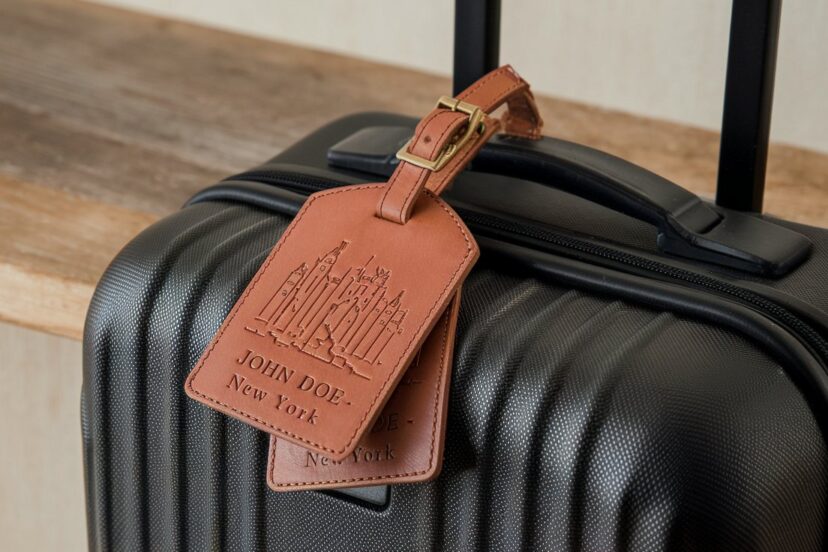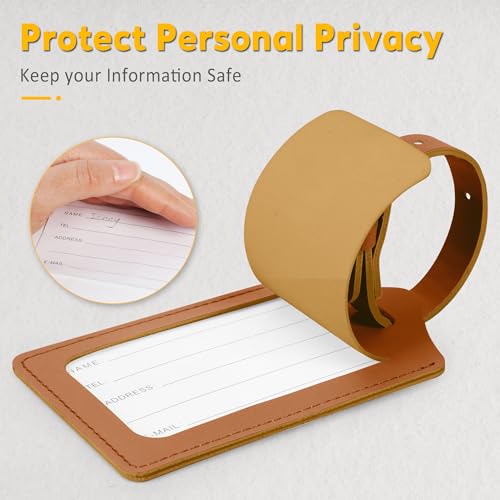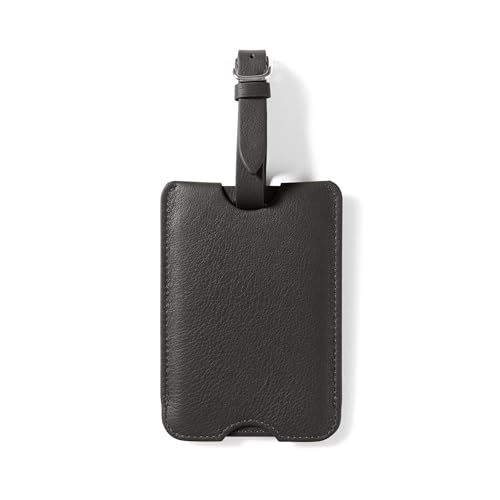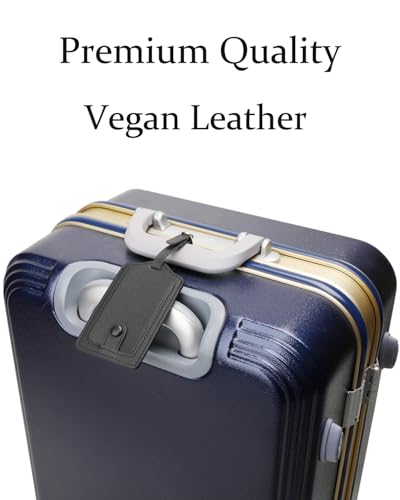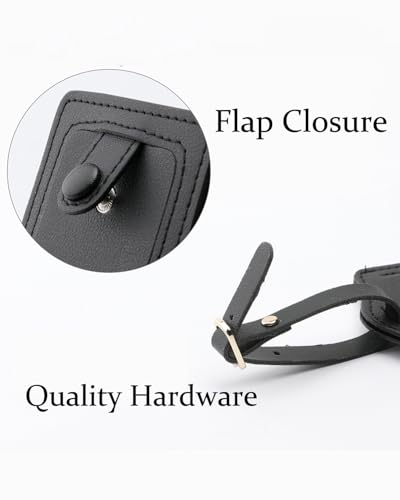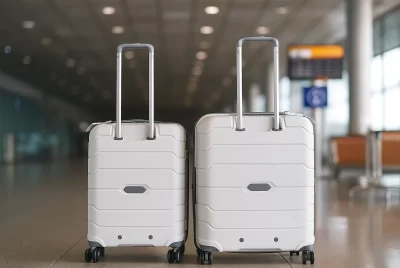Luxury on the Go: A Guide to Leather Luggage Tags
*We may earn a commission for purchases made using our links. Please see our disclaimer to learn more.
Let me tell you something that’s transformed my travel experience over the years – investing in quality leather luggage tags. After countless airport carousels and misidentification mishaps, I’ve discovered these small accessories aren’t just practical necessities but also stylish statements that elevate any journey. Whether you’re jetting off for business or embarking on a leisurely vacation, the right leather tag offers that perfect blend of functionality and elegance that few other travel accessories can match.
Key Takeaways
- Leather luggage tags offer superior durability compared to plastic alternatives, often lasting decades with proper care
- Quality full-grain leather tags develop a unique patina over time, adding character to your luggage and making it easily identifiable
- Privacy features like cover flaps protect your personal information from casual observers while maintaining accessibility when needed
- Personalization options allow you to make a statement while ensuring easy identification at baggage claim
- Investment in quality leather tags typically results in years of use, making them cost-effective in the long run despite higher initial costs
Top Recommended Leather Luggage Tags
1. Travelambo Faux Leather Luggage Tags
Upgrade your travel accessories with Travelambo’s stylish and functional faux leather luggage tags. Designed for durability and privacy, these tags feature a protective flap to keep your personal details secure while allowing for easy identification. With dual-sided printing and interchangeable cards, updating your information is effortless. Made from premium faux leather, these tags add a touch of sophistication to any suitcase, making them an essential for frequent travelers.
- Privacy Protection – Features a flap to conceal personal details.
- Durable Faux Leather – Stylish and built to last.
- Dual-Sided Info Cards – Easily switch between different addresses.
- Limited Space – Small card size may not fit long details.
- Faux Leather Material – Not as premium as genuine leather.
- Strap Durability – May loosen with heavy use.
This faux leather luggage tag set comes in a variety of colors to suit any style. One of the standout features is the privacy flap, which keeps your personal information hidden while still allowing quick access when needed. The extended strap ensures a secure attachment to your suitcase, reducing the risk of it coming loose during transit. At just $5.99 for a pack of two, these tags offer excellent value without sacrificing durability. Whether for weekend getaways or long-haul flights, they hold up well and make identifying your bags effortless.
2. Leatherology Deluxe Luggage Tag
Elevate your travel experience with the Leatherology Deluxe Luggage Tag, crafted from premium leather for a sophisticated touch. Designed for both style and security, this tag features a privacy sleeve to keep your personal details concealed while still allowing easy access. The adjustable buckled strap ensures a snug, secure fit on any luggage, while the polished finish adds a sleek, refined look. Whether for business or leisure, this durable and stylish tag makes baggage identification effortless.
- Premium Leather – Elegant, durable, and long-lasting.
- Privacy Sleeve – Keeps personal details secure and hidden.
- Adjustable Strap – Ensures a snug, secure fit on luggage.
- Higher Price – More expensive than other options.
- Limited ID Card Space – May not fit detailed contact info.
- Leather Maintenance – Requires care to maintain its finish.
This full-grain leather luggage tag from Leatherology combines elegance with practicality. Designed with a sleek privacy sleeve, it keeps your personal information hidden while allowing for quick access when needed. The polished finish and adjustable buckled strap ensure both durability and a secure attachment to your luggage. At $55, this premium tag offers a sophisticated touch for frequent travelers who value both style and function. Whether you’re heading on a business trip or a luxury getaway, this tag makes baggage identification effortless while maintaining a refined look.
3. Jagucho Leather Luggage Tags
Upgrade your travel gear with the Jagucho Leather Luggage Tags, designed for both functionality and style. Made from soft faux leather, these tags offer a lightweight yet durable solution for identifying your luggage. The adjustable PU strap with multiple holes ensures a secure fit on any bag, while the privacy flap and snap closure keep your personal details hidden. With a water-resistant design and double-sided ID card, these tags are perfect for frequent travelers, cruise-goers, and business trips.
- Privacy Flap – Keeps personal details secure and hidden.
- Adjustable Strap – Customizable fit for various luggage sizes.
- Water-Resistant – Protects ID cards from rain and spills.
- Faux Leather Material – Not as durable as genuine leather.
- Limited Color Options – Some may prefer more vibrant choices.
- Plastic Film Cover – May wear over time with heavy use.
This sleek set of Jagucho Leather Luggage Tags combines style and security for worry-free travel. Crafted from soft faux leather, these tags are lightweight yet durable, with reinforced stitching for longevity. I love the privacy flap that discreetly conceals personal information while remaining easily accessible when needed. The adjustable PU strap ensures a snug fit on any suitcase, backpack, or duffel bag. At under $10 per tag, they offer excellent value without compromising on quality. The water-resistant design also helps protect your ID card from wear and tear, making them an ideal choice for frequent travelers or cruise enthusiasts.
4. Samsonite 2-Pack Leather Luggage Tag
This Samsonite 2-Pack Leather Luggage Tag set offers a blend of classic style and durability for hassle-free travel. Made from smooth black leather, these tags add a touch of sophistication to any suitcase or carry-on. I love the protective leather flap, which keeps your personal details discreet while still allowing quick identification when needed. The adjustable strap and sturdy buckle ensure a secure fit, so you don’t have to worry about losing your tag mid-journey. At $18 for a set of two, they provide premium quality at a reasonable price, making them a great choice for business and leisure travelers alike.
- Design - Elegant and timeless black leather
- Privacy - Protective flap keeps personal details secure
- Durability - Sturdy buckle and strap ensure a secure attachment
- Color Options - Only available in black
- Price - Slightly more expensive than some alternatives
- Wear Over Time - May develop scuffs with heavy use
These streamlined, professional-looking tags come in a pack of four, making them ideal for families or those with multiple bags. The clear ID window is protected by a leather flap, and the adjustable leather strap accommodates various luggage attachment points. At roughly $25 for four tags, this represents the best value proposition on our list without sacrificing quality. I recommend these to colleagues who travel with multiple pieces of luggage, as the consistent look creates a cohesive travel aesthetic while ensuring each bag is properly identified.
The Enduring Appeal of Leather Luggage Tags
There’s something undeniably special about leather accessories. In an age of disposable goods and mass production, leather items stand as a testament to craftsmanship and durability. This is particularly true for luggage tags, which must withstand rough handling, varied weather conditions, and years of use.
A Brief History of Luggage Identification
Identifying one’s belongings while traveling isn’t a new concept. In fact, travelers have been marking their possessions for centuries. From wax seals used by wealthy travelers in the 17th and 18th centuries to the introduction of paper tags in the early days of commercial rail and air travel, the need to quickly identify baggage has always existed.
Leather luggage tags became popular during the golden age of travel in the early 20th century, when steamship trunks and leather suitcases were the norm. These early tags were often crafted by the same leatherworkers who made the luggage itself, creating a cohesive look for well-heeled travelers. Vintage luggage from luxury brands like Louis Vuitton and Goyard featured distinctive leather identification tags that have inspired modern designs.
As air travel became more accessible in the mid-20th century, standardized paper tags became commonplace for airline identification purposes. However, savvy travelers continued to use personal leather tags as both a practical tool and a style statement. Today’s leather tags honor this tradition while incorporating modern features like privacy protection and durable attachment methods.
Why Leather Remains the Superior Choice
In my experience, leather tags offer numerous advantages over their plastic or paper counterparts:
Durability
Quality leather can last decades with proper care. Unlike plastic tags that crack or paper tags that tear, leather withstands the rigors of travel admirably. I still use a leather tag my father gave me fifteen years ago, and it looks better now than when it was new. The natural oils in leather make it resistant to water damage, and unlike synthetic materials, minor scratches and marks only enhance its character rather than diminishing its appearance.
Aesthetics
Let’s be honest, appearances matter. A well-crafted leather tag elevates even the most basic luggage, adding a touch of sophistication. As leather ages, it develops a patina unique to its owner and experiences, telling the story of your travels in its very appearance. This natural aging process is something synthetic materials simply cannot replicate, making each leather tag increasingly distinctive over time.
The tactile quality of leather also adds to its appeal, there’s a certain satisfaction in handling a well-made leather accessory that smooth plastic or laminated paper can’t match. Whether you prefer the buttery softness of Italian leather or the rugged texture of American bridle leather, the sensory experience is part of the charm.
Security
Many leather tags feature privacy flaps or closures that keep your personal information concealed while still being accessible when needed. This extra layer of protection isn’t just about privacy, it also helps prevent the information from being damaged by moisture or abrasion. In an era of increasing concern about identity theft, the ability to control who sees your personal details is a significant advantage.
Some premium leather tags even incorporate RFID-blocking technology, protecting any embedded digital information from unauthorized scanning. While this may seem excessive for a simple luggage tag, it reflects manufacturers’ attention to modern security concerns.
Recognition
The distinctive look of a quality leather tag makes spotting your bag on the carousel significantly easier. This practical benefit can save precious minutes after a long flight when you’re eager to begin your journey or return home. I’ve lost count of the number of times I’ve quickly identified my bag among a sea of similar suitcases thanks to the distinctive burgundy leather tag I attach to all my checked luggage.
Beyond the practical aspects, there’s also something deeply satisfying about maintaining a tradition that connects modern travelers with those of previous generations. In a world where so much of travel has become homogenized, these small touches of individuality and craftsmanship matter more than ever.
Choosing the Right Leather Luggage Tag
Not all leather tags are created equal. Throughout my years of travel, I’ve developed a keen eye for quality and functionality in these seemingly simple accessories. The right choice depends on your specific needs, aesthetic preferences, and budget.
Types of Leather
Full-Grain Leather
Considered the highest quality leather available, full-grain leather includes the entire grain surface of the hide, with all natural markings. This type of leather is extremely durable and develops a beautiful patina over time. While initially more expensive, full-grain leather tags will outlast cheaper alternatives many times over.
What I appreciate most about full-grain leather is its authenticity, each piece has unique natural markings that tell the story of the animal it came from. These variations in grain and texture become more pronounced over time, making your tag increasingly distinctive with use. The tight fiber structure also provides excellent resistance to moisture and wear.
Top-Grain Leather
Slightly less expensive than full-grain, top-grain leather has had the uppermost layer sanded away to remove imperfections. While still durable, it won’t develop the same rich patina as full-grain leather. However, it often has a more uniform appearance, which some travelers prefer.
Top-grain leather offers a good compromise between quality and cost. It’s more resistant to staining than full-grain leather, making it a practical choice for frequent travelers who value appearance. The sanding process creates a slightly thinner leather that’s more pliable, which can be advantageous for tags that need to bend around luggage handles.
Genuine Leather
Despite what the name suggests, “genuine leather” is actually a lower grade of leather. It’s made from the layers of hide that remain after the top and full-grain portions are removed. While still functional, these tags won’t last as long and don’t develop the same character over time.
Tags made from genuine leather are typically more affordable, making them an acceptable entry point for someone uncertain about investing in higher-quality options. They can still offer years of service if well-constructed and properly maintained. However, they’re more susceptible to damage from moisture and rough handling.
Bonded Leather
The lowest quality option, bonded leather is made from leather scraps bonded together with adhesives. I’d recommend avoiding bonded leather tags, as they tend to peel and deteriorate quickly, especially with frequent travel.
Though sometimes marketed with terms like “reconstituted leather” or “blended leather,” bonded leather is essentially the particleboard of the leather world. It lacks the structural integrity of natural leather fibers and typically begins to deteriorate after minimal exposure to the elements. The adhesives used in its construction can also fail when exposed to temperature extremes commonly encountered during travel.
Design Features to Consider
Attachment Method
The most common failure point for luggage tags is the attachment. Look for tags with durable buckles, sturdy straps, or metal loops. Leather straps with buckles tend to be the most secure, while simple loops might be easier to transfer between different pieces of luggage.
I prefer tags with stainless steel or brass hardware, as these materials resist corrosion and maintain their appearance over time. Some premium tags feature adjustable straps that accommodate different thicknesses of luggage handles, which provides greater versatility. For maximum security, look for designs where the strap threads through a slot in the tag itself, creating a closed loop that can’t easily slip off.
Information Display
Consider how your personal information will be displayed and protected. Options range from open display (not recommended for privacy reasons) to completely concealed information that requires opening the tag to view. Most quality tags offer a balance, a window covered by a leather flap or a simple closure mechanism.
Some tags come with pre-printed cards for your information, while others allow you to insert a standard business card. The latter option can be particularly convenient for travelers who frequently update their contact information or who travel to different regions where alternative contact details might be more appropriate.
Size and Visibility
The tag should be large enough to be easily visible but not so bulky that it becomes cumbersome. Bright colors can make identification easier, though classic brown and black leather offers a timeless look that matches most luggage.
For checked luggage, I prefer slightly larger tags that are easy to spot from a distance. For carry-on items or personal bags, a more discreet tag is often preferable. Some manufacturers offer matching sets in different sizes to accommodate this range of needs.
Personalization Options
Many leather tags can be personalized with monograms, names, or even custom artwork. This not only adds a personal touch but also makes your luggage instantly recognizable and less likely to be mistakenly taken by another traveler.
Personalization methods range from simple hot-stamping of initials to elaborate engraving or embossing. Some companies even offer the option to include symbols or small logos meaningful to the owner. While personalization typically adds to the cost, it significantly enhances both the functional and sentimental value of the tag.
Caring for Your Leather Luggage Tags
One of the reasons I’ve been able to use the same leather tags for years is proper maintenance. Leather requires some care, but the effort is minimal compared to the extended lifespan it provides.
Basic Maintenance Tips
- Keep it dry: While quality leather can handle some moisture, prolonged exposure to water can damage it. If your tag gets wet, allow it to air dry naturally away from direct heat sources. Once dry, apply a small amount of leather conditioner to restore suppleness.
- Clean periodically: Wipe your tag with a slightly damp cloth to remove dust and dirt. For deeper cleaning, use a leather cleaner specifically designed for the type of leather your tag is made from. Always test any product on an inconspicuous area first.
- Condition regularly: Leather can dry out over time, leading to cracking. Applying a small amount of leather conditioner every few months will keep it supple and extend its life. This is particularly important if you travel to areas with dry climates or if your tags are frequently exposed to air conditioning, which can accelerate drying.
- Avoid extreme temperatures: Try not to leave your tagged luggage in extremely hot or cold conditions for extended periods, as this can damage the leather. Direct sunlight can fade colored leather, while extreme cold can make leather brittle and more susceptible to cracking.
- Store properly: When not in use, store your tags in a cool, dry place away from direct sunlight to prevent fading and drying. If you travel infrequently, consider applying a light coat of conditioner before storing your tags for extended periods.
The Environmental Case for Leather
In an era of increasing environmental consciousness, it’s worth considering the sustainability aspects of our choices. While leather production does have environmental impacts, quality leather products like well-made luggage tags can actually be a more eco-friendly choice than synthetic alternatives when viewed over their entire lifecycle.
A plastic tag might last a year or two before needing replacement, while a well-maintained leather tag can easily last for decades. This longevity means fewer resources consumed over time and less waste sent to landfills. Additionally, leather is biodegradable, unlike many synthetic materials that may persist in the environment for hundreds of years.
Of course, not all leather is created equal from an environmental standpoint. Tags made from leather that’s vegetable-tanned using traditional methods tend to have a lower environmental impact than those using chrome tanning processes. Some companies are now offering leather tags made from hides that are byproducts of the food industry, further reducing their environmental footprint.
For the most environmentally conscious consumers, options like ethically sourced leather from small-scale producers or reclaimed vintage leather offer ways to enjoy the benefits of leather while minimizing environmental impact. Several innovative companies now offer leather alternatives made from plant materials like pineapple leaves, mushrooms, or apple peels, providing options for those who prefer to avoid animal products entirely.
Beyond Identification: The Cultural Significance of Leather Tags
Throughout history, the materials we choose for our possessions have carried meaning beyond mere functionality. Leather, with its associations of durability, craftsmanship, and timelessness, communicates something about the traveler who selects it.
In many cultures, leather items are given as significant gifts to mark important occasions. A quality leather luggage tag can serve as a meaningful gift for graduates embarking on new journeys, newlyweds setting off on honeymoons, or executives taking on international roles. The combination of practicality and personal significance makes these small accessories particularly appropriate for marking transitions and new beginnings.
For many travelers, there’s also a ritual aspect to preparing for a journey. The act of attaching a familiar leather tag to a suitcase can be part of this preparation, a small moment of connection with previous travels and adventures yet to come. As the tag accumulates scratches, stains, and marks from different destinations, it becomes a physical record of experiences, a tactile connection to memories of places visited and journeys undertaken.
Conclusion
A quality leather luggage tag is more than just a practical tool for identifying your bags, it’s a small luxury that enhances the travel experience. The right tag combines functionality with aesthetics, serving as both a practical necessity and a reflection of personal style.
Through my years of traveling, I’ve found that few accessories offer the same combination of practicality, durability, and sophistication as a well-crafted leather luggage tag. Whether you’re a frequent flyer or an occasional traveler, investing in quality leather tags is a decision you’re unlikely to regret.
The tags I’ve recommended represent some of the best options, catering to different preferences and price points. Whichever you choose, proper care will ensure it remains a faithful companion through countless journeys, possibly even becoming an heirloom passed down to future generations of travelers.
In a world where so much of travel has become standardized and impersonal, these small touches of individuality and craftsmanship remind us of travel’s romantic heritage while serving an eminently practical purpose. By choosing leather, we connect ourselves to the long tradition of thoughtful travelers who understood that how we travel, down to the smallest details, is as important as where we go.
Frequently Asked Questions
Most quality leather tags offer reasonable privacy through design features like cover flaps or closures. However, for maximum security, I recommend including only essential information on your tag, a name and phone number are typically sufficient. Consider using a business address rather than your home address, and never include sensitive information like your Social Security number or frequent flyer details. Some travelers prefer to list an email address rather than a physical address, providing a way to be contacted without revealing their home location.
Quality full-grain and top-grain leather tags can handle occasional exposure to moisture without significant damage. However, prolonged saturation can cause issues. If your tag gets wet, allow it to dry naturally and apply a leather conditioner once dry. Some manufacturers offer weather-treated leather that provides additional protection against the elements. For travelers who frequently visit rainy or snowy destinations, looking for tags that have been treated with water-resistant finishes or natural oils can provide added peace of mind without sacrificing the aesthetic appeal of leather.
How do I attach a leather luggage tag securely to different types of baggage?
Most leather tags come with a strap that buckles or loops around a handle. For maximum security, thread the strap through a fixed part of your luggage rather than removable handles. For bags without obvious attachment points, consider luggage tags with steel cable loops that can secure to zippers or other small openings. Always check that the attachment is secure before checking your bag. For backpacks or soft-sided luggage, reinforced attachment points are particularly important, as the movement of these bags can put additional stress on the tag’s connection point.
What’s the best way to make my leather luggage tag distinctive without compromising quality?
Choose a less common color or opt for personalization such as monogramming or custom artwork. Many quality leather companies offer stamping or embossing services. Another approach is to select a tag with a distinctive shape or design while maintaining the quality of the leather itself. Remember that quality full-grain leather will develop a unique patina over time, making your tag increasingly distinctive with use. Some travelers add small, subtle embellishments like a distinctive knot in the leather strap or a small charm attached alongside the tag—these personal touches can make identification even easier while maintaining the tag’s elegance.
Is it worth paying more for a high-end leather luggage tag?
In my experience, yes. The price difference between budget and premium leather tags is typically $15-30, but the difference in longevity can be measured in years or even decades. Premium tags usually feature better quality leather, superior stitching, and more secure attachment mechanisms. When amortized over their useful life, high-quality leather tags often prove more economical than repeatedly replacing cheaper alternatives. Beyond the practical considerations, there’s also the daily pleasure of using a beautifully crafted item, something that’s difficult to quantify but adds significantly to the overall travel experience. I’ve found that quality leather accessories like luggage tags are small luxuries that provide disproportionate satisfaction relative to their cost.

